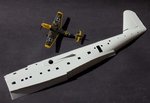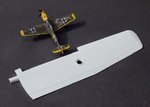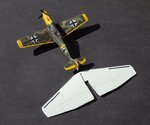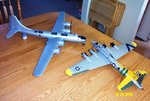User Name : Wayne Little
Name : Wayne
Category : Non Competing Judge
Kit : Revell Blohm und Voss Bv222 V2
Scale : 1/72
Accessories : Most likely Eduard Seatbelts and their Antenna Array
The Blohm Voss BV 222 Wiking (German: "Viking") was a large, six-engined German flying boat of World War II. Originally designed as a commercial transport, and produced in only limited quantities, it was both the largest flying boat and largest aircraft to achieve operational status during the war.
The V2 (CC+ER) made its first flight on 7 August 1941, and after extensive testing was assigned to LTS 222 on 10 August 1942 as X4+AB. Since the aircraft was intended for long-distance overwater flights, in addition to the armament fitted to the V1 she received two rear-facing wing-mounted turrets with dual 13 mm (.51 in) MG 131s, accessed via the tubular wing spar which was 1 m (3 ft 3 in) in diameter.
In 1944, the V2 participated in Operation Schatzgräber ("Treasure Seeker"), the code name of a German weather station at Alexandra Land in the Arctic, whose sick crew needed to be evacuated. The BV 222 dropped a spare wheel for a Fw 200 which had sustained damage during landing near the station.
For this mission a White overspray was applied to provide some measure of camouflage against the Arctic landscape and this will be how my Bv222 will be depicted.
Name : Wayne
Category : Non Competing Judge
Kit : Revell Blohm und Voss Bv222 V2
Scale : 1/72
Accessories : Most likely Eduard Seatbelts and their Antenna Array
The Blohm Voss BV 222 Wiking (German: "Viking") was a large, six-engined German flying boat of World War II. Originally designed as a commercial transport, and produced in only limited quantities, it was both the largest flying boat and largest aircraft to achieve operational status during the war.
The V2 (CC+ER) made its first flight on 7 August 1941, and after extensive testing was assigned to LTS 222 on 10 August 1942 as X4+AB. Since the aircraft was intended for long-distance overwater flights, in addition to the armament fitted to the V1 she received two rear-facing wing-mounted turrets with dual 13 mm (.51 in) MG 131s, accessed via the tubular wing spar which was 1 m (3 ft 3 in) in diameter.
In 1944, the V2 participated in Operation Schatzgräber ("Treasure Seeker"), the code name of a German weather station at Alexandra Land in the Arctic, whose sick crew needed to be evacuated. The BV 222 dropped a spare wheel for a Fw 200 which had sustained damage during landing near the station.
For this mission a White overspray was applied to provide some measure of camouflage against the Arctic landscape and this will be how my Bv222 will be depicted.
Attachments
Last edited by a moderator:





